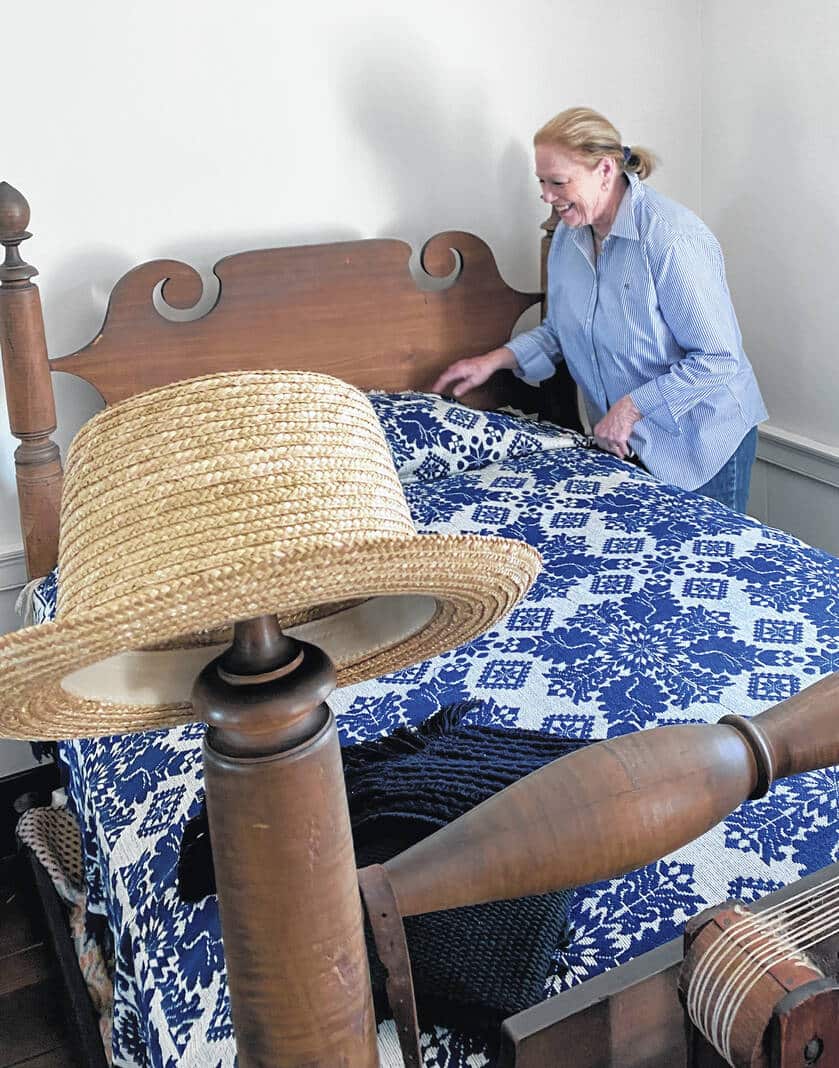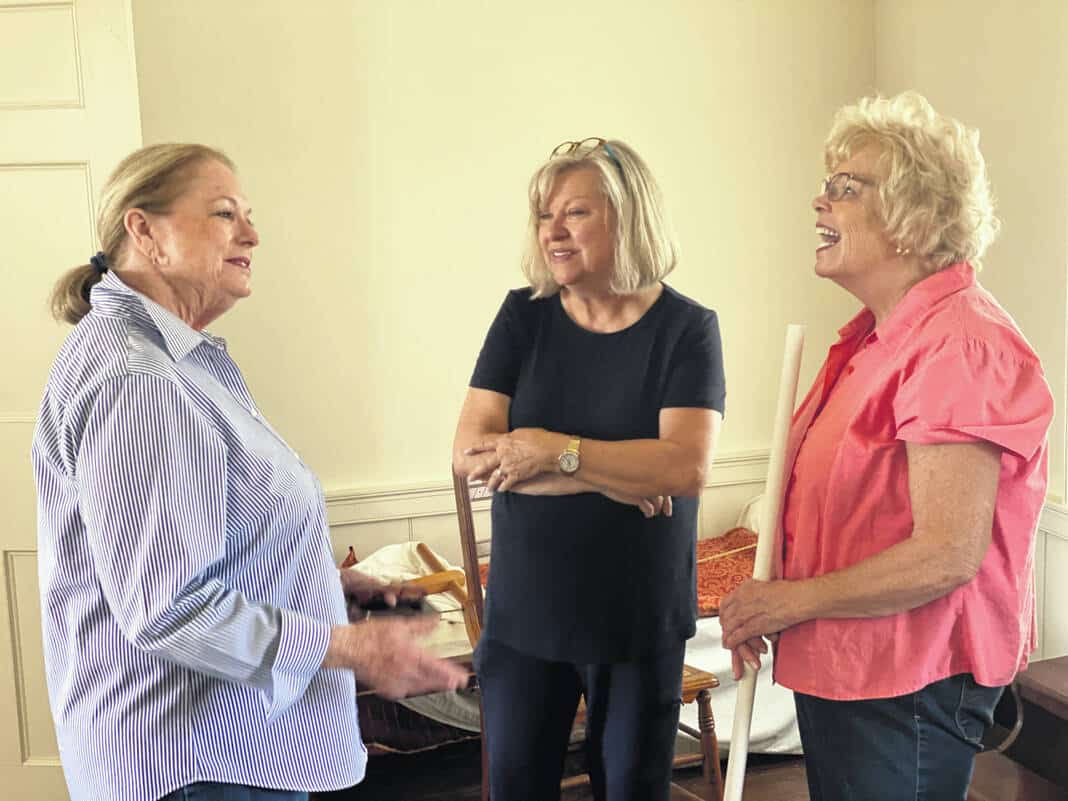
Margaret French looks at a painting of John Johnston that hangs in the dining room of the Johnston Farm home. Johnston had the painting commissioned on one of his many trips to the east and then shipped to his home.
Courtesy photo

Margaret French smooth’s the wrinkles on a coverlet on one of the beds in the “boys room” inside the Johnston Family home.
Courtesy photo

Margaret French discusses the renovations of the home with Sharon Bledsoe, center, and Lynda Adams, right. Both Bledsoe and Adams were involved in interior redesign of the Johnston Family home.
Courtesy photo
PIQUA — Margaret French, who by her own admission, has “served on the board of the Johnston Farm & Indian Agency since Moses was a small boy floating down the Nile River in a reed basket”, recently decided to retire.
“It seemed like a good time to step aside,” she said in a recent interview. “The board had just undergone a strategic planning process and we were able to identify and establish a clear direction for the future of the site.”
“In addition, the board is comprised of strong leaders,” French said. “We recently undertook a major capital campaign to restore the John and Rachel Johnston family home. The renovation of the home is complete.”
“We are in the final stages of renovating and expanding the museum,” French said. “Long-time site manager Andy Hite will soon be retiring. The site is about to celebrate the 50th anniversary as one of Ohio’s historic sites owned and managed by Ohio History Connection. As I looked back over the long period I’ve served on the board, it just seemed like a good time to step aside,” she repeated.
“There is a quote of which I am particularly fond,” French said. “’Sometimes the road of life takes an unexpected turn and you have no choice but to follow it to end up in the place you are supposed to be.’”
“When I was a child, both of my parents were employed at Colonial Williamsburg,” French explained. “We lived in a home on Duke of Gloucester Street right next to the boot shop. My dad provided vocal and instrumental music at Josiah Chowning’s Tavern. When I would get home from school, I’d hang out at the boot shop, and by age nine, I was working as a costumed interpreter there.”
When she was 11, the family moved to Hawaii. Fast forward several years, it was in Hawaii that she met and fell in love with Dan French.
“I really knew nothing about this part of the country,” she said. “Until I met Dan, I’d never heard of Piqua!”
“That all changed quickly, of course,” French noted. “Once I moved here, I quickly learned how important this area was. There are literally thousands of years of history represented at the Johnston Farm site alone.”
French was referring to the fact that the Johnston Farm is one of more than 1,000 documented sites across Ohio where indigenous people known as mound builders once lived. There were three distinct groups of mound builders who lived in what is now Ohio. They practiced agriculture and likely chose the site because of the abundant supply of water (in addition to the river, the spring located on the property was one of the factors that caused John Johnston to choose the site for his home centuries later).
“While we’ll likely never know for sure, we believe that Native Americans from eastern North America who were mostly hunters, came into the Ohio Territory and waged a war against the primarily agricultural Mound Builders,” French stated. “Later Mound Builder sites that have been identified as the Fort Ancient Culture were constructed upon elevated positions, with walls surrounding increasingly larger villages. The elevated positions and earthen walls suggest that these sites were created as defensive positions.”
“Excavations of grave sites show numerous remains that had arrowheads embedded in the skeletons,” French further explained. “Some remains have multiple arrowheads. There are remains that have been found that show signs of animal teeth marks suggesting that the individual may have been killed outside the compound and left to scavengers before being brought inside for proper burial.”
The Johnston Farm site is also the location of Pickawillany, one of the largest known Miami Indian “villages.” The “village” was estimated to have between 1,250 and 2,500 inhabitants. Pickawillany was destroyed (June 21, 1752) in a raid by a combined force of French and Indians as a prelude to the French and Indian War.
As a wagoner in General “Mad” Anthony Wayne’s Legion of the United States, Johnston was in his teens when he first set eyes on the verdant land along the Great Miami River that would eventually become his family’s home. He described the area in a letter he wrote in 1838.
“The first time I saw the spot upon which I now live, the determination was formed if ever the land could be purchased I would at any price commensurate with my means become the owner of a tract of about 250 acres of elevated, rich dry prairie, covered with grass. Skirted with the most beautiful woods, an unusually large and never failing spring of the purest and coldest water springing out of the second bank of the Great Miami River, immediately in the rear of which lay a delightful building spot, 40 feet above the river, half a mile below the mouth of the Loramie Creek.”
“Johnston was ultimately able to purchase the land in what was then referred to as Upper Piqua,” French stated, “and as they say, the rest is history. It is clear to me that John Johnston truly loved the land on which he built his home. He and Rachel raised their fifteen children here. And, it was here that he buried his beloved wife, several of his children who preceded him in death, and it was here that he himself chose to be buried.”
“John Johnston was able to convince the five tribes under his care to remain peaceful during the War of 1812,” French said. “Had they sided with the British, we might well not be standing here today. As you know, we didn’t fare very well in that war, and the addition of several thousand Miami, Shawnee, Wyandot, Seneca, and Delaware warriors to the British side might well have resulted in the war having a far different outcome.”
“I think one of the things I admire most about John Johnston is that he was truly a Renaissance man,” French noted. “Not only was he an Indian agent who the Native American trusted and respected, he was a progressive farmer, canal commissioner, published author, a founder of Kenyon College, a trustee of Miami University, and a member of the Board of Visitors of West Point.”
“In every way, Rachel was his equal,” French continued. “She was educated, something that was unusual for women of that period. She was also a leader in religious and educational matters. In many ways, her leadership paralleled that of her husband.”
“I suspect that few of us can really imagine what life on the frontier would have been like,” French stated. “As John Johnston himself recorded, ‘in the front room, the floor would be covered with blankets, cloaks, buffalo robes, and such articles as travelers carry with them for the purpose of camping out. No one ever looked for a bed in those times. It was not unusual for twenty or thirty persons to lodge with us for a night. Indians, missionaries, soldiers – General Harrison and his aides were often guests. We lived on the extreme edge of the frontier, and travelers could nowhere else find accommodations.’”
“I’ve truly enjoyed my service on the board,” French said. “I look forward to watching the site continue to develop in the coming years.”
“Margaret will be missed,” Johnston Farm Council President Michael Gutmann stated. “Both Margaret and Dan have both been tremendous supporters of the site. I always knew that when Margaret took charge of a project, it would be done well and ahead of schedule. I’ll certainly miss her.”
Long time site manager Andy Hite agreed. “Margaret was an integral part of so many projects over the years that no matter what superlatives I used, they would not be enough to do justice to the contributions she has made to the Johnston Farm. We will indeed miss her presence at board meetings,” Hite said, “but I have to think she’ll still play a role at the site in future years. The Johnston Farm is not the kind of place you just walk away from and not return.”


